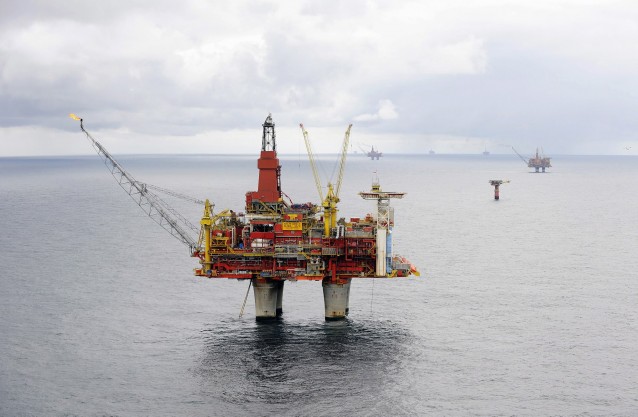http://thinkprogress.org/climate/2014/01/27/3207201/limited-statoil-/
After 8,400 Gallon Oil Spill, Safety Standards On Norwegian Offshore Rigs Questioned
By Emily Atkin on January 27, 2014 at 12:06 pm
The Statfjord C rig.
CREDIT: Statoil
Approximately 32 cubic meters, or 8,400 gallons, of oil spilled into the sea early Sunday morning following a leak at a Statoil-owned rig off the coast of Norway, according to media reports and a company statement.
“It has been confirmed that a limited amount of oil has leaked into the sea,” the Norway-based company said, noting that the leak had been stopped. “We are currently working on mapping the extent of the leak. The platform has been shut down.”
Though weather was not indicated as the cause, Statoil confirmed that harsh conditions and high waves were preventing emergency response teams from adequately observing the area immediately following the spill, and that it would inspect the area from the air. The spill originated from an area in the rig’s drainage system that was supposed to trap liquids, the company said, but did not note how or why the drainage system failed. The rig’s crew of 270 people were ordered onto lifeboats, Statoil said.
Statoil said it would launch an in-house investigation of the spill’s cause. Norway’s police and Petroleum Safety Authority also said it would probe the incident.
“We view an oil leak into the sea as serious,” company spokesman Morten Eek told Bloomberg News. “Statfjord C is shut and won’t be started again before we’ve had the system verified.”
statfjord location
CREDIT: Statoil
The Statfjord C platform is part of the Statfjord fields, which produce about 80,000 barrels of oil a day through its A, B, and C platforms, according to Statoil’s website. Though Statoil does not give production value of the oil obtained via the Statfjord platforms, Statfjord holds the record for the highest daily production ever recorded for a European oil field outside Russia.
Statoil’s production has also likely helped Norway’s recent influx of riches. The country’s sovereign wealth fund ballooned in the last year because of high oil and gas prices, with the fund — which collects taxes from oil profits and invests the money, mostly in stocks — exceeding 5.11 trillion crowns ($905 billion) in value last week. Theoretically, that made everyone in Norway worth a million crowns per person, or about $177,000 per Norwegian.
Safety on Norway’s offshore rigs, however, has been an issue for some in the country. Just one day after Sunday’s spill, four unions that represented Norwegian offshore oil rig workers decided to withdraw from an industry-sponsored safety group, saying the offshore rig industry was ignoring critical safety standards.
The group, called the Norwegian Oil and Gas Association’s Network for Safety and Emergency Response Training (NSOB), was originally established in the wake of a 1980 platform disaster that killed 123 people. But now, the four unions — Fellesforbundet, Industri Energi, Lederne and SAFE — said NSOB had recently made “a number of changes that impair safety and emergency training on the Norwegian continental shelf.”
“For us, it appears that cost savings and superficiality have taken precedence at the expense of safety and emergency response,” Fellesforbundet Secretary Mohammed Afzal said in a statement to UPI news.
Special thanks to Richard Charter
